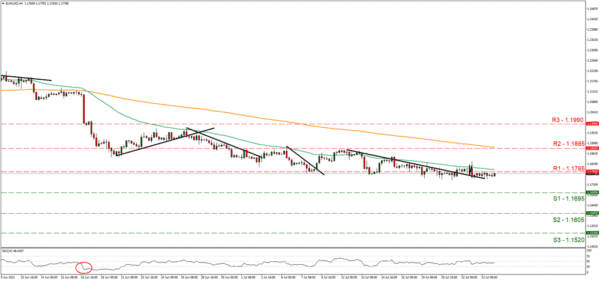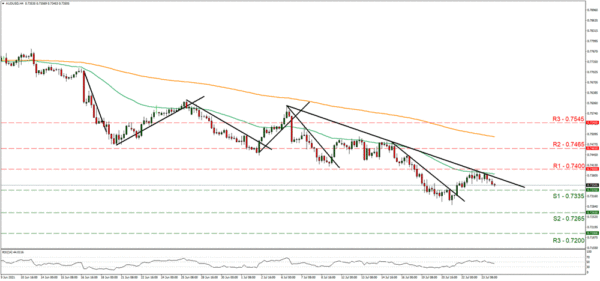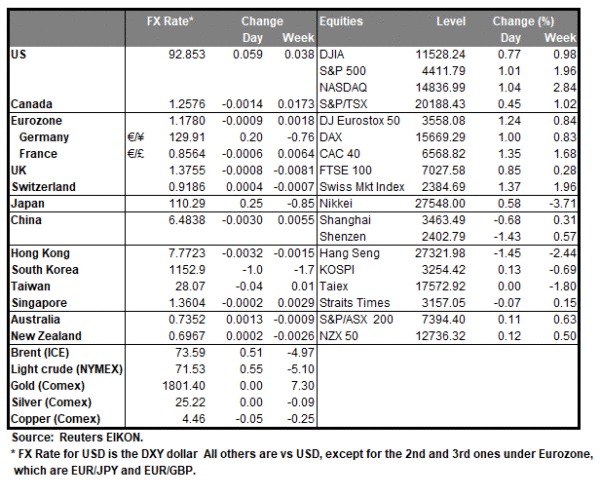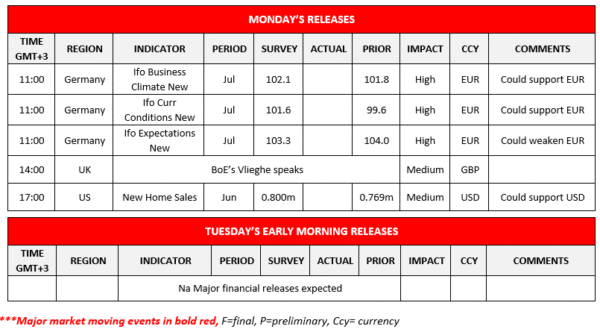The greenback remained near three and a half month high levels against the common currency in a tight range bound movement as the attention of the financial markets focus is on the release of the Fed’s interest rate decision on Wednesday. The pound weakened against the USD and the EUR on Friday, as July’s preliminary PMI readings showed an unexpected slowdown of economic activity for the month of July spreading disappointment, despite retail sales for June accelerating. The AUD weakened on Friday despite the global risk sentiment improving somewhat, as the ongoing lockdown measures applied for nearly half of Australia’s population tended to weigh on the Australian currency, while also Iron Ore prices fell sharply adding to the worries of Aussie traders. US equities rebounded and ended the week higher on Friday with all three main stock indexes reaching new record highs also supported by the earnings season especially in the tech sector. Gold prices remained rather stable albeit inched higher on Monday, maybe getting some support buy dropping US Treasury yields and rising worries for the Delta variant of Covid.
EUR/USD remained in a rather tight range bound motion just below the 1.1785 (R1) resistance line. We tend to maintain a bias for a sideways motion, given the pair’s movement since the 19th of the month as well as the RSI indicator which remains near the reading of 50, implying a rather indecisive market. Should a selling interest be displayed by the market, we may see the pair breaking the 1.1695 (S1) support line and aim for lower grounds. On the other hand, should buyers take over the initiative over the pair’s direction, we may see the pair breaking the 1.1785 (R1) resistance line and aim if not breach the 1.1885 (R2) resistance level.
AUD/USD retreated on Friday aiming for the 0.7335 (S1) support line. We tend to maintain a bearish outlook for the pair as long as it remains below the downward trendline since the 6th of July. Also note that the RSI indicator below our 4-hour chart is between the reading of 50 and 30, which may imply that the bears may have a slight advantage. Should the bears actually continue to guide the pair’s direction, we may see it breaking the 0.7335 (S1) line and aim for the 0.7265 (S2) support level. If the bulls take over, we may see the pair breaking the downward trendline, the 0.7400 (R1) resistance line and aim for the 0.7465 (R2) level.
Other economic highlights today and the following Asian session:
Today we get during the European session Germany’s Ifo indicators for July, while in the American session we get the US new home sales figure for June. On the monetary front we note the planned speech of BoE’s Vlieghe near the end of the European session.
As for the rest of the week
On Tuesday, we get UK’s CBI Distributive trades for July, UK the US durable goods orders for June and the US Consumer Confidence for July. On Wednesday, BoJ is to release the summary of opinions for its last meeting and we get Australia’s CPI rates for Q2, Germany’s GfK Consumer Sentiment for August, Canada’s inflation rates, while in the US the Fed is to release its interest rate decision. On Thursday, we get UK‘s Nationwide house prices for July, Sweden‘s GDP rate for Q2, Eurozone‘s economic sentiment for July, Germany‘s preliminary HICP rate for July, and from the US the GDP advance rate as well as the weekly initial jobless claims figure. On Friday, we get Japan‘s preliminary industrial output for June, France‘s preliminary GDP rate for Q2, Germany’s preliminary GDP rate for Q2, France’s preliminary CPI (EU Normalised) rate for July, Switzerland’s KOF indicator for July, and Eurozone’s preliminary HICP and GDP rates for July and GDP respectively.
Support: 1.1695 (S1), 1.1605 (S2), 1.1520 (S3)
Resistance: 1.1785 (R1), 1.1885 (R2), 1.1990 (R3)
Support: 0.7335 (S1), 0.7265 (S2), 0.7200 (S3)
Resistance: 0.7400 (R1), 0.7465 (R2), 0.7545 (R3)

















